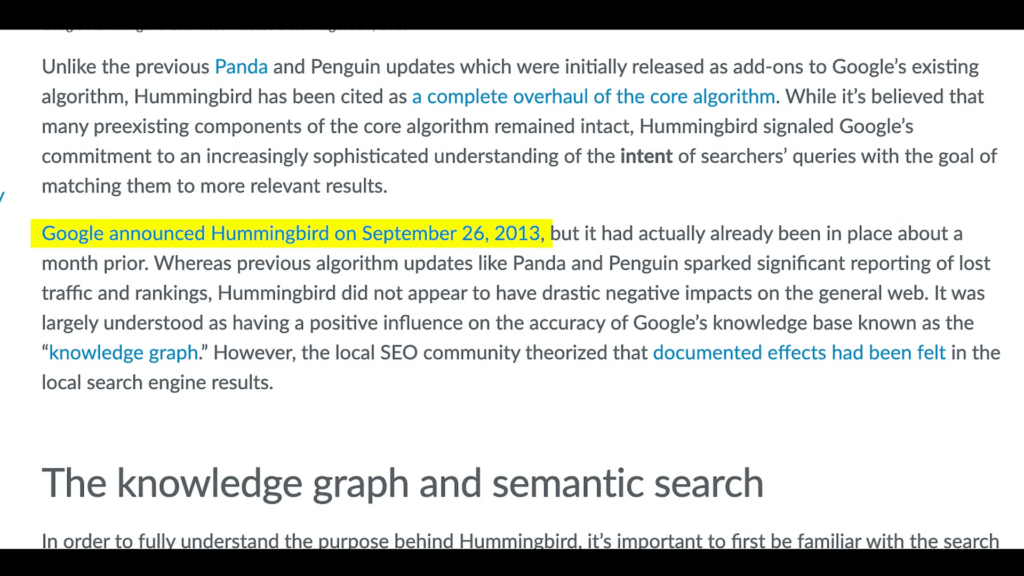Understanding Google ranking factors is crucial here; we focus on expired signals and their relevance. For example, external factors are especially considerable, and understanding those ranks helps you optimize your website more properly.
What Are Google Ranking Signals? 📊
Google’s algorithm uses a ranking signal as a tool to gauge how relevant or authoritative a web page is. Brandwise influence and brand equity can affect a website’s SERP positions. We have implemented several signals over time, some of which have been retired, while others have been integrated into more advanced systems.
Expired factors remain significant for webmasters and SEO professionals by providing effective techniques.
Those six expired ranking signals determine search rankings.
1. Hummingbird Update 🐦
Google’s Hummingbird update, launched in 2013, improved search query processing by analyzing related keyword phrases for better context understanding.
The Hummingbird update was ignored at first, but its influence grew over time. It assisted in the eradication of spinning and the overall enhancement of the content provided to the users. The search engine algorithms now incorporate the principles of recent updates, making it a modern SEO phenomenon.

2. Mobile-Friendly Ranking System 📱
The Mobile-Friendly Ranking System introduced in 2015 gave preference to websites that functioned effectively on mobile devices. With the help of smartphones increasing this ranking system assisted much in ensuring mobile users were able to have a better experience.
Nevertheless, Google did not eliminate this ranking system but synthesized it into the Page Experience System. The Page Experience System includes several segments, with mobile-friendliness remaining a key component for ranking. This means that while the mobile-friendly ranking system is now fully incorporated into the Page Experience System, its principles still influence how ranking occurs.

3. Page Speed System ⏱️
The introduction of the Page Speed System takes us back to July 2018, when it emphasized an improvement in the waiting time for web page loads. It was qualitative for websites with a short time loading which was structural insufficiency. What is more, this system has also been abutted into the Page Experience System.
As it stands, the Page Experience System measures page speed with the use of three core metrics – Largest Contentful Paint, First Input Delay, and Cumulative Layout Shift. The inclusion of these metrics covers over 60% of the Page experience system and therefore it renders the Page speed system redundant.

4. Panda System 🐼
The Panda System was introduced as a strategy to go after low-quality and spammy content during that year. The system penalized sites relying on content spinning and encouraged the use of new and original content. 2015 has integrated Google’s core Algorithm with Panda, influencing rankings as a part of it instead of being a separate signal.
The Panda update emphasizes the importance of quality content for SEO, requiring websites to invest in fresh, relevant content to maintain high rankings.

5. Penguin System 🐧
The Penguin System appeared in 2012 and its primary goal was to prevent the manipulation of backlinks. New techniques dumpster several such link wheels and private blog networks that tried to steal the blood that had just hit. The shift happened in 2016 when the algorithms that devalued spam links came into the domain of Penguin. There were reports about how the webmasters abused the systems by buying thousands of low-grade links from retched sites.
Webmasters must follow procedures to maintain a clean backlink profile and avoid penalties, aiming for higher search result rankings.
6. Secure Site System 🔒
The Secure Site System was rolled out in 2014 being a great advantage against the browsers not supporting HTTPS. Of course, this ranking signal has also been incorporated into the Page Experience System. HTTPS, once an independent factor, now contributes to Page Experience; sites should use it for user safety and improved rankings.

Conclusion: The Evolution of Google Ranking Signals 🔄
Analyzing factors that have been forfeited in the process of ranking by Google is a crucial practice for SEO practitioners. Although such signals may have lost their stand-alone status, their principles and practices perpetuate the ranking concepts by Google. By tracking changes, webmasters and SEO specialists adjust tactics for current ranking strategies.
As with any other aspect of the world, SEO must change as well. Enhancing SEO with quality content, mobile optimization, fast loading, and secure browsing boosts search ranking competitiveness.

